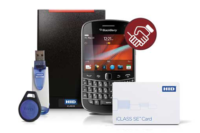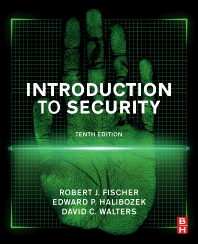
The access control reader has for years been almost an afterthought technology-wise, placing second to the fast-changing world of card technologies. Of course, the two go hand-in-hand, but readers have had a slower track to significant change, only recently branching out from the same Wiegand protocol that was employed 30 years ago.
In an age where everything is “smart” from cards to phones to home appliances, it is only natural that manufacturers are taking a fresh look at the access control reader and asking, “how can we make it do more than just read a specific card technology?” The results are a new and upcoming generation of smarter, more powerful and more secure readers that can effectively take users forward from whatever legacy technology they have now to whatever they choose 10 to 15 years from now.
“We are always out there trying to match the requirements to the end users’ needs,” says Walter Helms, vice president and CTO, Matrix Systems, Miamisburg, Ohio. “From my perspective, on the integration side readers used to be straight input devices. They didn’t bring much to system intelligence. You found a reader that could read back and that is all you had to worry about. But now, intelligence in the readers is increasing and they are becoming an active part of the overall system.”
Not only that, but reader technology is expanding the market as well, says Stephanie Hensler, director of EAC OEM sales, Assa Abloy, New Haven, Conn. “As far as readers go they are becoming smarter. Manufacturers are looking at ways to make it easier to have additional openings. Whether it is inside the lock or an edge device, people are becoming more creative in access control in how we can gather more openings.”
For example, says Michael Radicella, president, ISONAS, Boulder, Colo., his company recently installed more than 1,200 readers at a single school location. “We are figuring out places where new access control readers will fit that they didn’t used to. The school wanted to add the readers one at a time and on every door, but they didn’t want all those panels of a traditional system. Customers are just waiting for us to come up with new solutions for problems that have been out there for a long time, but needed a product that matched.”
Talking Tech
New applications and needs are being addressed in a number of ways by access control reader technologies.
“I think one of the biggest things is implementing multi-technology readers,” says Jennifer Toscano, marketing manager for readers and credentials, Ingersoll Rand, Carmel, Ind. “The multi-tech reader enables integrators or customers who are putting in proximity solutions today to be prepared for smart technology in the future. We are seeing a lot more people use smart cards. It is really about addressing the customer’s needs today and helping them prepare for the future. Either you are selling smart card readers today or using proximity credentials if the customer is not ready, but implementing multi-tech readers that will enable that technology in the future.”
Mas Kosaka, CEO, PCSC, Torrance, Calif., agrees. “Multi-class readers have the ability to ‘grow’ with customers’ needs. Most readers can only read one type of technology, like proximity. What customers are looking for are card technologies that will enable them to ‘keep up with technology.’”
Multi-technology readers have been traditionally employed as “transition” devices — particularly between proximity and smart cards. These devices, which used to be considered a relatively short-term solution, are being reinvented as a longer-term solution that will take end users forward to any standardized card technology they choose.
“Multi-tech readers have been instrumental in getting a lot of customers migrated from even older technology than prox to the smart card,” says Lisa DeBettignies, president, Access Specialties International LLC, Rosemount, Minn. “We’ve been doing this for about 20 years and technology has changed so dramatically from the beginning to now. In the last year, the availability of multi-tech cards and readers and also the ability to get them from multiple manufacturers has provided a nice migration path for our customers.”
Dave Adams, senior product marketing manager, HID, Irvine, Calif., does not like the term “smart” for the new generations of multi-tech readers, but he does see them making an impact.
“They are not ‘smart.’ They do need to be told what to do. But they are more powerful. We are putting processors in our readers today that people once thought would only be used in controllers. You wouldn’t think you would need that kind of power.”
What it will allow, however, is the ability to keep the reader on the wall and upgrade to new card technologies as they become available.
“The way we are building our readers we foresee in the next year or two they will be able to fit virtually any technology need,” Adams says. “If someone has DESFire or iClass, it will read it. If they still have old prox, it will read that. We have been building multi-tech readers for quite some time but we have been restricted in how much technology you can cram into that one little box. Now we can pack far more into them and that allows them to navigate to the data on the card without having to be specifically built for that technology.”
IR recently introduced a lock/reader combination designed to serve a similar purpose, Toscano says. “It is a lock that is also a reader. That enables people to have the flexibility to address their needs today and tomorrow. If they need prox today they can put that reader on it. If they need to upgrade their credential, they can change the reader on the door without changing the mechanical hardware as well and increase the overall life cycle of the product.”
Edge devices, or combined reader/controllers are another reader configuration making waves.
“Edge devices are a strong trend,” Adams says. “We have the happy problem that our edge readers can hardly keep up with the demand because they are so easy to install they make a lot of sense. They are not perfect for every installation, but year after year they have been our highest growth-rate product.”
ISONAS recently received a patent for its edge device, which is a networked device designed to work using PoE (Power over Ethernet).
“You don’t need specialized cables anymore, just a CAT 5. Once you can do that, it makes it easier to get to any door,” Radicella says.
“One of our primary product areas is the trend towards IP and integrated reader/controllers that allow customers to use their existing infrastructure,” DeBettignies adds. “More and more new business is growing that way rather than the traditional Wiegand reader.”
In fact, some end users are starting to say ‘no more’ to the Wiegand protocol, period.
“Starting about a year ago we have been seeing big integrators and OEMs come right out and say they have got to get away from Wiegand,” Adams says.
Indeed, the way that readers communicate both with the cards and with the panels and network is one of the biggest advancements in the works.
“Network-on-card is becoming a new catch phrase,” Helms says. “Readers that use smart cards with all the information on the card essentially replace a panel, which is a major dynamic change to the overall structure.”
Connectivity & Communication
With all of this information being passed between card and reader, however, the need for higher security is paramount, says Dennis Geiszler, vice president of marketing and international sales, Keri Systems, San Jose, Calif.
“What we will see coming up is the advent of readers that have encryption between card and reader so that the data going back and forth cannot be ‘sniffed,’” he describes.
Adams agrees. “Everyone knows about the MIFARE hack and proximity is not secure to begin with, so now we are talking about doing things with cards and readers that were thought undoable before in a contactless manner. We are using certificates and PKI to authenticate not only the card, but the identity that is contained on the card. That is a trend driven by the government that has been talked about for years, but now they are saying ‘this is where we need to go — now.’”
In addition to being more secure, the communication between card and reader is becoming bi-directional, as well — opening the door for all kinds of possibilities.
“We are seeing more and more high-speed, bi-directional communication, rather than the standard Wiegand, which has been used for 30 years. There is a big push for that,” Adams adds.
What this is doing, explains Tim McCarthy, product manager, Paxton Access, Orlando, Fla., is paving the way for increased functionality and communication at the reader level.
“We now have the ability to customize readers with a customer’s own brand name, look, orientation or message. Before, it was just a straight Wiegand signal, but now we can actually interpret data and configure the reader to accept or deny data at the reader level.”
Paxton has a reader line that can customize messages when a card is presented. “For example, if a reader happens to be at a conference room, the message could change depending on the time of day and the meetings scheduled,” he describes. “Readers are adapting to the daily environment as opposed to just sitting there, stagnant.”
Two-way communication also provides opportunities for troubleshooting in an intelligent way, Geiszler adds. “Our readers have a two-way communication with the controller. If they go offline or are broken the controller knows about it and can send an alarm so someone can investigate.”
Getting away from Wiegand also has the advantage of allowing for more installation opportunities, says Gary Staley, national sales director and founding partner, RS2 Technologies, Munster, Ind.
“Wiegand protocol only allowed a maximum of 500 feet from the panel to the reader. Newer protocols allow up to 4,000 feet.”
That and the ability to used standard CAT 5 cabling are really making things more flexible for the installer in terms of where they locate the readers and controllers.
Future Features
At the present time, a lot of these new developments are in the works. Some, such as edge readers, networking and bi-directional communication are here now. Others are a year or two — or more — away. But manufacturers envision exciting developments in the future for access control readers.
“The reader is now going to be a networked device,” Radicella emphasizes. “Time was where that was in question, but clearly it is happening. Whether it plugs in directly to the host or still to the panel, then the host is up for grabs. We are panel-free.”
That is a direction more and more readers are likely to take, Adams says. “I see the communication to readers maybe getting away from being hardwired to a controller altogether. Having a straight IP reader, just an Ethernet-connected reader, used as a virtual IP link to a very intelligent controller would be pure IP. With new requirements coming up from the federal government, we really have to go to an IP reader to enable the high-speed and high-bandwidth connectivity to things like certificate authorities and controllers and the host systems themselves.”
Also near-term is the logical progression of multi-tech readers to “universal” readers, Adams believes. “We are probably in the 12- to 18-month range from having these available. As readers become more powerful and universal, this will allow dealers and integrators to have only one SKU that they have to carry — one reader that sits on your shelf. Now they have to make a good guess at what group of readers end users might want, but the new trend towards universal readers will streamline that.”
Further down the line, but a trend that is working its way from general culture to security, is credential-free, says Steve Dentinger, director of marketing, Keyscan Inc., Whitby, Ontario, Canada.
“Higher-end vehicles today allow you to push a button to start your car. We are seeing technology present around us that doesn’t require you to hold anything in your hand per se. Biometrics is not widely accepted in the market right now, but as costs go down I see it making an impact. We have seen facial recognition employed on laptops. As soon as the price point makes it more accessible it could really impact access control as we know it. A company we work with has a pilot application where you walk up to a camera and it does a double iris scan without you putting your eyes up to a machine. If we can get to a point where you don’t have to carry a credential at all that is pretty impressive.”
Whatever is coming, dealers and integrators need to prepare for it now, and one way is to choose a forward-thinking reader.
Toscano likens it to the smart phone. Five years ago, no one could have predicted everything these phones can do today. And smart cards are similar, she says.
“A lot of dealers and integrators today don’t need to do a lot with the smart card. They need a reader to read it and that’s all. But they know they will need to do more with it in the future. Most integrators are looking at smart card readers in terms of they don’t know what customers are going to do with it tomorrow, but they know they will want to do more. By looking for readers that read multiple technologies, dealers can not only minimize inventory but start positioning smart card and multi-tech readers to their customers because it helps them prepare for the future.”
The Bottom Line: Multi-Tech Readers
SDM asked manufacturers which card reader technologies they thought would have the greatest impact on the security industry and why. Here’s what they had to say about multi-technology readers:
“The availability of multi-technology card readers will prove to be a key for the industry in that it will support not only existing card infrastructure but also the superior security offered by 13.56 MHz smart card technology.” — Steve Dentinger, director of marketing, Keyscan Inc.
“Multi-technology readers provide a method to transition legacy systems to more secure badge technologies without forcing mass-rebadging or disruptions in normal operation.” — Walter Helms, vice president and CTO, Matrix Systems
“It is very important that all organizations be prepared for smart credential deployment, even if that facility wants to install proximity, magnetic stripe or keypad readers at present.” — Jennifer Toscano, marketing manager for readers and credentials, Ingersoll Rand
“I think what we have been talking about with this universal reader concept will have the biggest impact on the industry because it puts power back into end users’ hands. They will decide what technology they want and integrators will be able to easily and quickly deliver that because of these new, powerful readers.” —
Dave Adams, product marketing manager, HID
The Bottom Line: IP/Intelligent Readers
SDM asked manufacturers which card reader technologies they thought would have the greatest impact on the security industry and why. Here’s what they had to say about IP/intelligent readers:
“Readers are becoming intelligent system components, not just an entry device. Such readers are taking on not only door control functions but highly configurable, functional and significant capabilities.” — Walter Helms, vice president and CTO, Matrix Systems
“Smarter readers that communicate with the controller (two-way communication) in a non-Wiegand manner can report their status as well as being able to receive firmware upgrades for new features.” —Dennis Geiszler, vice president of marketing and international sales, Keri Systems
“Because a reader can plug directly into an ‘IP network’ it completely changes/simplifies the landscape starting with the site planning, physical installation all the way through to the configuration and maintenance of the application.” — Michael Radicella, president, ISONAS





